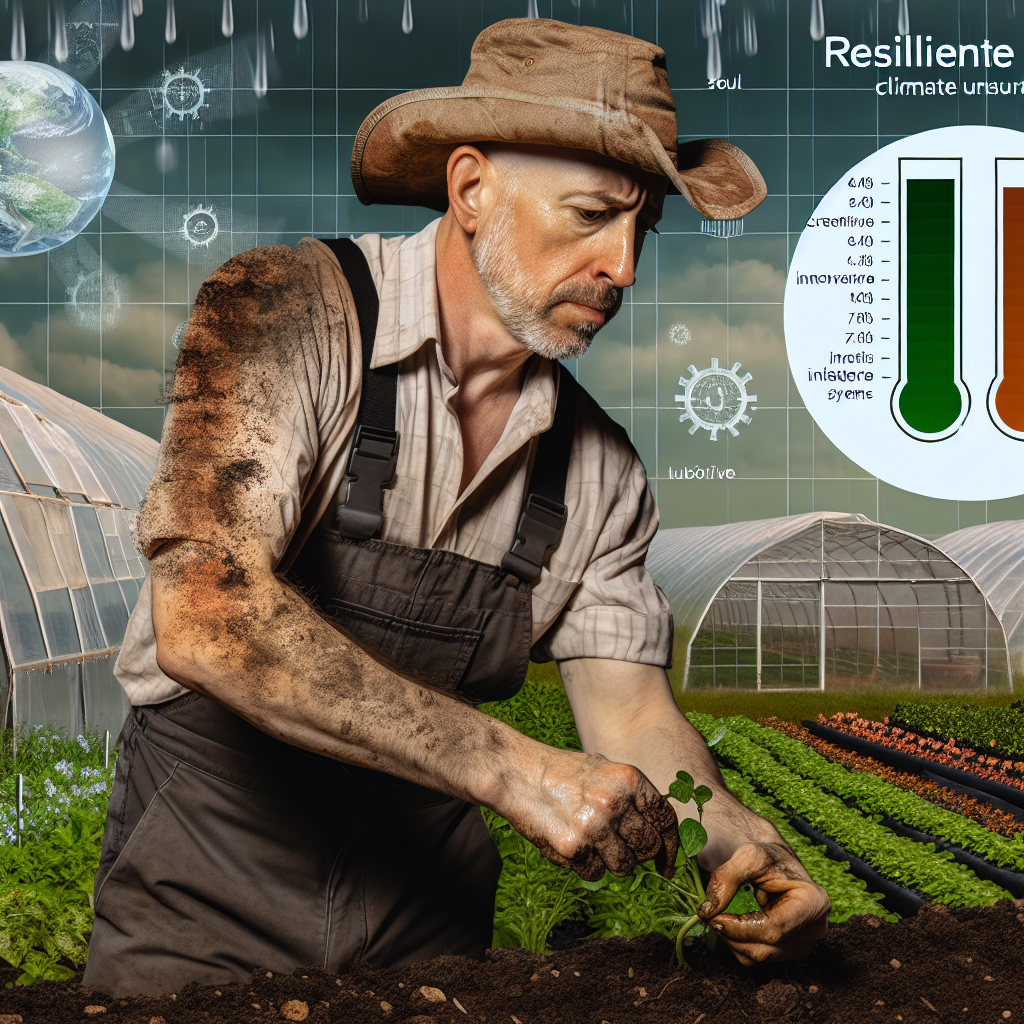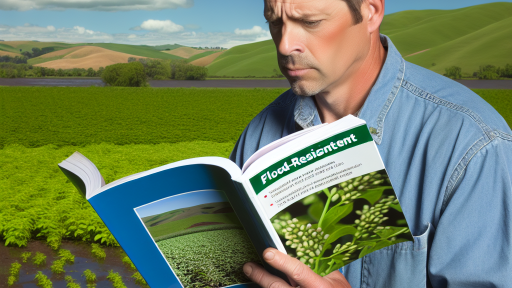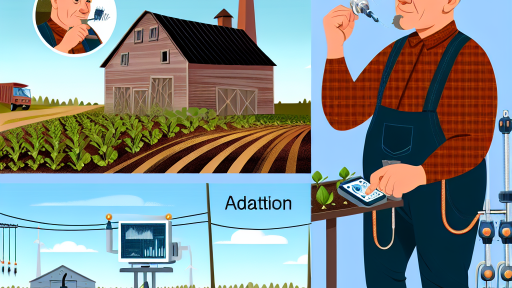Understanding Climate Change: Its Impact on Agriculture
Defining Climate Change
Climate change refers to long-term shifts in temperatures and weather patterns.
These changes result from human activities, especially the burning of fossil fuels.
Consequently, significant greenhouse gases accumulate in the atmosphere.
Effects on Weather Patterns
Farmers now face unpredictable weather conditions.
For instance, droughts and floods have become more frequent and severe.
Hence, crop yields can vary drastically from year to year.
This unpredictability complicates planning and resource allocation.
Influence on Crop Production
Certain crops struggle to adapt to new climatic conditions.
Heat stress can lead to reduced yields and lower quality produce.
Pests and diseases may thrive in warmer temperatures.
This situation poses additional challenges for farmers.
Impact on Soil Health
Climate change can degrade soil quality over time.
Increased rainfall often leads to soil erosion and nutrient loss.
Negative impacts on soil health can diminish crop productivity.
Therefore, sustainable farming practices are essential for soil preservation.
Transform Your Agribusiness
Unlock your farm's potential with expert advice tailored to your needs. Get actionable steps that drive real results.
Get StartedWater Resources and Agriculture
Changes in precipitation patterns affect water availability for irrigation.
Some regions may experience droughts, limiting water resources.
Conversely, other areas may face excessive rainfall, increasing flooding risks.
This variability necessitates efficient water management strategies.
Addressing Economic Challenges
Climate change poses significant economic risks for farmers.
Crop failures can lead to financial losses and increased production costs.
Additionally, market prices can fluctuate unpredictably.
Thus, farmers must develop strategies to mitigate financial risks.
Adopting Resilience Strategies
Building resilient farms involves implementing adaptive agricultural practices.
Crop diversification can help buffer against climate-related risks.
Soil health management is vital for enhancing agricultural sustainability.
Farmers should also utilize technology for efficient resource management.
Lastly, community collaboration can aid in sharing knowledge and resources.
Assessing Current Farming Practices and Their Vulnerabilities
Introduction to Current Practices
Farmers employ various practices to enhance production efficiency.
Conventional farming remains prevalent across many regions.
This approach often relies heavily on machinery and chemical inputs.
In contrast, organic farming is gaining traction for its sustainability.
Identifying Vulnerabilities
Current farming practices face significant vulnerabilities from climate change.
For instance, changing weather patterns disrupt planting and harvesting schedules.
Additionally, extreme weather events pose direct threats to crop yields.
Consequently, soil degradation affects the resilience of agricultural systems.
Understanding Soil Health
Soil health is crucial for sustainable agriculture.
Healthy soil fosters robust crop production and resilience against pests.
Moreover, it enhances water retention and reduces erosion risks.
Showcase Your Farming Business
Publish your professional farming services profile on our blog for a one-time fee of $200 and reach a dedicated audience of farmers and agribusiness owners.
Publish Your ProfileRegular soil testing helps farmers make informed decisions.
Water Management Challenges
Water scarcity presents a major challenge for farmers globally.
Erratic rainfall patterns necessitate improved irrigation techniques.
Farms must adopt water-efficient practices to conserve this resource.
Implementing rainwater harvesting can significantly aid water management.
Adapting to Pests and Diseases
Pests and diseases are becoming harder to control with climate shifts.
Integrated pest management strategies can mitigate these threats.
Crop rotation and diversification enhance resilience against infestations.
Educating farmers about emerging pest issues is essential.
The Role of Technology
Modern technology offers solutions to many farming vulnerabilities.
Precision agriculture enhances input efficiency and reduces costs.
Data analytics can predict climate impacts on crop productivity.
Moreover, drones facilitate timely monitoring of crop health.
Community and Policy Engagement
Engaging with local communities strengthens farmer resilience.
Collaborating on sustainable practices leads to shared resources.
Additionally, supportive policies encourage innovative agricultural methods.
A collective effort enhances adaptation to ongoing climate challenges.
Implementing Sustainable Agriculture Techniques
Adopting Crop Rotation
Crop rotation enhances soil health and fertility.
This technique minimizes pest issues and disease cycles.
By alternating crops, farmers restore nutrients in the soil.
Moreover, it leads to higher yields over time.
Integrating Agroforestry
Agroforestry combines agriculture and forestry practices.
This method enhances biodiversity on the farm.
It provides shade and habitat for various species.
Additionally, it reduces soil erosion.
Utilizing Cover Crops
Cover crops protect the soil during off-seasons.
They prevent soil erosion and suppress weeds.
Furthermore, cover crops enhance soil organic matter.
This practice improves overall soil health.
Implementing Precision Agriculture
Precision agriculture uses technology to optimize field management.
Farmers can monitor crop variability using sensors.
This data-driven approach increases efficiency and productivity.
Consequently, it reduces waste and conserves resources.
Emphasizing Water Management
Effective water management practices conserve valuable resources.
Farmers can implement drip irrigation systems.
This method delivers water directly to plant roots.
In turn, it reduces evaporation and runoff.
Promoting Organic Farming
Organic farming avoids synthetic chemicals and pesticides.
This approach enhances soil biodiversity and health.
Furthermore, it produces safer food options.
Showcase Your Farming Business
Publish your professional farming services profile on our blog for a one-time fee of $200 and reach a dedicated audience of farmers and agribusiness owners.
Publish Your ProfileConsumers increasingly demand organic products.
Encouraging Community Supported Agriculture
Community Supported Agriculture (CSA) connects farmers and consumers.
Members buy shares of the harvest in advance.
This system promotes local food production and consumption.
It fosters a sense of community and accountability.
See Related Content: Assessing the Financial Impacts of Climate Variability on Farms
Utilizing Technology for Climate Resilience in Farming
Precision Agriculture
Precision agriculture optimizes field-level management.
This method adapts to variability in crops.
Farmers use GPS technology for precise planting.
Additionally, sensors monitor soil moisture levels.
Consequently, farmers can apply water more effectively.
Data analytics further improve decision-making processes.
As a result, crop yields increase while minimizing waste.
Climate-Smart Tools
Innovative tools enhance climate resilience in farming.
For instance, drones assist in crop monitoring.
Farmers use drones to identify pest issues quickly.
Furthermore, remote sensing technologies provide vital data.
This ensures timely interventions to protect crops.
Integrated Pest Management
Technology supports integrated pest management strategies.
Farmers track pest populations through software applications.
Additionally, they can predict outbreaks with accuracy.
This information aids in targeted pesticide application.
Thus, it reduces the overall pesticide usage.
Soy Health Monitoring
Continuous soil health monitoring is essential.
Farmers utilize soil sensors to measure nutrient levels.
Moreover, they analyze soil health data regularly.
This practice helps in optimizing fertilization strategies.
Consequently, farmers enhance crop resilience against climate stressors.
Water Management Solutions
Effective water management is critical for sustainability.
Smart irrigation systems automate watering processes.
Sensors measure moisture and adjust water supply.
These innovations conserve water while promoting growth.
Farmers experience reduced costs from efficient usage.
Data-Driven Decision Making
Data-driven approaches empower farmers to make informed choices.
Farm management software consolidates vital information.
This enables farmers to analyze trends and forecasts.
Thus, they can adapt practices based on predicted climate scenarios.
Ultimately, this enhances long-term farm viability.
Delve into the Subject: Precision Agriculture Tools for Better Water Management
Diversifying Crops: Benefits and Strategies
Understanding Crop Diversification
Crop diversification involves growing a variety of crops on the same land.
Showcase Your Farming Business
Publish your professional farming services profile on our blog for a one-time fee of $200 and reach a dedicated audience of farmers and agribusiness owners.
Publish Your ProfileThis practice helps to mitigate risks associated with climate variability.
Moreover, it enhances soil health and promotes biodiversity.
Farmers can gain economic stability by spreading their investments across different crops.
Benefits of Crop Diversification
Diverse crops improve resilience against pests and diseases.
Different plants can naturally repel harmful insects, reducing the need for pesticides.
Additionally, diversified crops can better adapt to changing climate conditions.
This adaptability allows farmers to stabilize their yields even during adverse weather events.
Strategies for Successful Diversification
Identifying suitable crops for rotation is essential for successful diversification.
Farmers should consider local climate, soil type, and market demand.
Implementing crop rotation can significantly improve soil fertility and structure.
Moreover, intercropping can maximize the use of available space.
Choosing crops with complementary growing seasons allows for year-round production.
Implementing Diversification Practices
Farmers can start small by introducing a few new crops to their existing fields.
Participating in local agricultural networks can provide support and knowledge sharing.
Furthermore, employing cover crops during off-seasons enhances soil health and nutrients.
Monitoring the performance of new crops will help refine future planting decisions.
Case Studies in Crop Diversification
Successful examples include farmers in California using almonds and olives together.
This combination has proven beneficial for both crops’ economic returns.
Similarly, Midwest farmers have integrated soybeans and corn to optimize land use.
These strategies illustrate the potential profitability of diversified farming systems.
Discover More: Sustainable Farming Techniques for Unpredictable Weather
Water Management Techniques to Combat Drought and Excess Rain
Importance of Effective Water Management
Effective water management is essential for resilient farming practices.
It helps farmers adapt to varying climate conditions.
Moreover, it minimizes water waste and improves crop yields.
Techniques for Managing Drought
Farmers can implement several strategies to combat drought.
First, rainwater harvesting provides an excellent solution.
This method captures and stores rainwater for future use.
Secondly, drip irrigation allows precise water delivery to crops.
This technique significantly reduces evaporation and runoff.
Additionally, mulching helps retain soil moisture.
It also moderates soil temperature, promoting healthy root growth.
Tools for Monitoring Soil Moisture
Utilizing technology can enhance water management capabilities.
Soil moisture sensors provide real-time data on water levels.
Farmers can adjust irrigation schedules accordingly.
Another effective tool is moisture meters, which guide planting decisions.
Strategies for Excess Rain Management
Farmers must also prepare for excessive rainfall events.
Installing drainage systems efficiently redirects excess water.
This infrastructure prevents crop flooding and soil erosion.
Cover crops enhance soil structure and absorb excess moisture.
They also help improve soil health in the long run.
Showcase Your Farming Business
Publish your professional farming services profile on our blog for a one-time fee of $200 and reach a dedicated audience of farmers and agribusiness owners.
Publish Your ProfileEngaging in Contour Farming
Contour farming is another effective practice for both scenarios.
This method involves plowing and planting across the slope of the land.
It reduces runoff and promotes water infiltration into the soil.
Consequently, this practice aids in managing both drought and excess rain.
Community Involvement and Education
Finally, community involvement plays a crucial role.
Farmers can share knowledge and techniques with each other.
Workshops and training can enhance understanding of water management.
Additionally, collaborating with local agricultural resources provides valuable support.
Find Out More: Farmers’ Toolkit for Climate Adaptation Success

Soil Health and Conservation: Building a Foundation for Resilience
Importance of Soil Health
Healthy soil is essential for resilient farming.
It supports plant growth and enhances biodiversity.
Additionally, healthy soil retains moisture and nutrients.
Consequently, this minimizes the need for chemical fertilizers.
Soil Conservation Practices
Implementing soil conservation practices improves soil quality.
No-till farming reduces soil erosion significantly.
Cover crops protect the soil during off-seasons.
Moreover, they enhance soil organic matter.
Crop rotation prevents nutrient depletion and pest buildup.
Building Soil Organic Matter
Increasing soil organic matter enhances its resilience.
Organic matter improves soil structure and water infiltration.
Composting and mulching are effective methods to build organic content.
Incorporating livestock manure also contributes beneficial nutrients.
Utilizing Technology for Soil Management
Technological advancements aid in monitoring soil health.
Soil sensors provide real-time data on moisture and nutrients.
Additionally, precision agriculture optimizes inputs based on soil needs.
This approach increases efficiency and reduces waste.
Community Involvement and Education
Engaging the community fosters better understanding of soil health.
Workshops and local farming groups share best practices.
Moreover, educational programs promote sustainable farming techniques.
This collective effort strengthens local food systems.
Long-term Benefits of Soil Conservation
Adopting soil conservation measures yields long-term benefits.
They enhance productivity and sustainability of agricultural lands.
Furthermore, healthy soils contribute to climate change mitigation.
Ultimately, resilient farms create a stable food source for communities.
Community and Cooperative Approaches to Resilient Farming
The Power of Community Support
Community support strengthens local farming initiatives.
Farmers who collaborate often share valuable resources.
They exchange knowledge and innovative practices effectively.
Additionally, community-driven initiatives enhance food security.
Members can collectively address local challenges.
Moreover, they can advocate for sustainable policies together.
Showcase Your Farming Business
Publish your professional farming services profile on our blog for a one-time fee of $200 and reach a dedicated audience of farmers and agribusiness owners.
Publish Your ProfileForming Cooperatives for Collective Benefit
Cooperatives enable farmers to pool resources efficiently.
Farmers can benefit from shared marketing and distribution.
They achieve better prices through collective bargaining.
Furthermore, cooperatives provide access to training and education.
This shared focus promotes sustainable practices across members.
Local Food Systems and Economic Resilience
Local food systems reduce carbon footprints significantly.
They support local economies by keeping money in communities.
Additionally, consumers appreciate fresh produce from nearby farms.
Establishing farmers’ markets enhances community engagement.
These markets foster relationships between farmers and consumers.
Sharing Resources and Knowledge
Resource-sharing networks help farmers access equipment.
This collaboration minimizes costs for individual farmers.
Knowledge-sharing workshops empower farmers with new techniques.
These workshops encourage innovation and adaptability.
Moreover, they foster a culture of continuous learning.
Building a Culture of Resilience
A resilient farming culture thrives on adaptation.
Community members encourage each other’s growth.
They celebrate successes and learn from failures together.
Working as a unified front strengthens overall resilience.
In this way, they prepare for future uncertainties collectively.
Policy Advocacy: Supporting Farmers in Climate Adaptation Efforts
Farmers face increasing challenges due to climate change.
It is essential for policymakers to support their adaptation efforts.
This support can take many forms, including funding and resources.
Effective advocacy can empower farmers to implement sustainable practices.
Identifying Key Policy Areas
Identifying key policy areas is crucial for effective advocacy.
Water management policies directly impact agricultural productivity.
Soil health regulations can enhance the resilience of farming systems.
Furthermore, climate-smart agriculture initiatives are vital for sustainable practices.
Creating Supportive Financial Mechanisms
Financial stability is critical for farmers adapting to climate change.
Subsidies for sustainable farming practices can alleviate immediate financial burdens.
Low-interest loans can help farmers invest in new technologies.
Grants for research can foster innovation in climate resilience strategies.
Engaging Communities and Stakeholders
Community engagement is vital for successful policy advocacy.
Building coalitions among farmers, NGOs, and government agencies increases influence.
Hosting workshops allows farmers to share experiences and strategies.
Collectively addressing challenges leads to more robust solutions.
Promoting Education and Training Programs
Education is key to effective climate adaptation.
Training programs can equip farmers with necessary skills and knowledge.
Workshops on sustainable farming practices should be widely available.
Additionally, online resources can reach a broader audience.
Showcase Your Farming Business
Publish your professional farming services profile on our blog for a one-time fee of $200 and reach a dedicated audience of farmers and agribusiness owners.
Publish Your ProfileMonitoring and Evaluating Policy Impact
Monitoring policy effectiveness ensures continuous improvement.
Regular assessments highlight successful strategies and areas for improvement.
Feedback from farmers is crucial for refining policies.
Data-driven approaches guide future advocacy efforts.
Case Studies: Successful Resilient Farms Around the World
Innovative Practices in Brazil
In Brazil, Fazenda da Toca exemplifies resilient farming practices.
This farm integrates agroforestry and organic gardening techniques.
By diversifying crops, it minimizes risks related to climate change.
Moreover, it utilizes cover crops to enhance soil health.
This approach results in improved yields and reduced erosion.
Community-Based Solutions in India
In India, the Khet Experiment showcases community resilience.
Farmers collaborate to share knowledge and resources.
This cooperation leads to better water management systems.
Additionally, they practice rainwater harvesting for irrigation.
Such methods empower local farmers to adapt to seasonal changes.
Technological Advancements in the Netherlands
The Netherlands is known for its advanced agricultural technology.
Wageningen University collaborates with farmers to innovate practices.
They utilize precision agriculture to optimize resource use.
This ensures minimal waste and maximal productivity.
Greenhouses with climate control also enhance crop resilience.
Permaculture in Australia
In Australia, the Permaculture Research Institute demonstrates sustainable methods.
They focus on integrating natural ecosystems into farming practices.
This technique improves biodiversity and soil moisture retention.
As a result, this leads to greater food security in arid regions.
Farmers report lower input costs and increased crop resilience.
Agroecology in Africa
Kenya’s smallholder farmers use agroecological practices effectively.
They emphasize local seed varieties that are drought-resistant.
This adaptation significantly boosts local food security.
Additionally, they practice intercropping for resource efficiency.
This holistic approach strengthens their resilience against climate variability.




